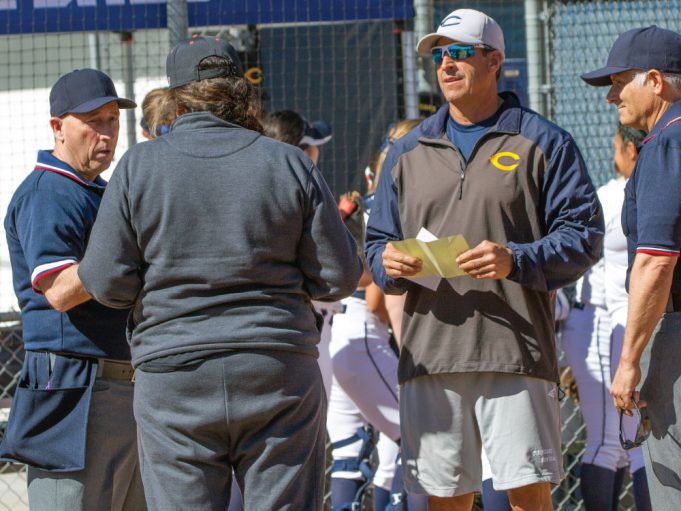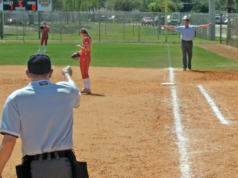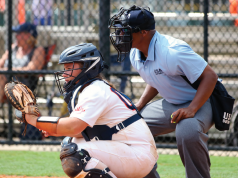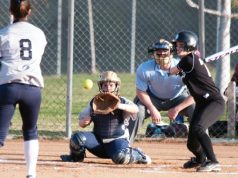T
here tends to be a debate among umpires regarding what should and should not be brought to the attention of coaches when it comes to lineup management during a game. On one side, it is suggested umpires should notify coaches any time they notice something wrong in the name of preventive umpiring to prevent assessing any penalties later in the game. On the other side, some argue umpires should never interfere when it comes to lineup card management as that is considered coaching.
In reality, the truth lies somewhere in between. There are some instances when an umpire should interject to prevent issues and it would be appropriate to do so. In others, an umpire should remain silent and not take away an opponent’s opportunity to appeal. Below are some examples of both and how they should be handled.
Coaches meeting.
The first opportunity an umpire has to look at the lineup card is at the coaches meeting prior to the game. Too often, umpires don’t take adequate time to look over the card and simply accept the card a coach hands to them. However, coaches often have a lot on their minds and they can easily make a mistake on the lineup card when filling it out prior to the game. This is especially true at the high school and travel ball levels. Coaches are often rushing from their day jobs or, in the case of travel ball, playing multiple games in a day and they rush to fill out the card. Those mistakes sometimes happen at the higher levels as well and umpires should not assume the card is perfect.
Umpires need to make sure all the information is adequately supplied on the card for the level they are working. Check to make sure the DP/Flex players are in the proper positions on the card, make sure there is one defensive position listed for every player, every player has a number and there are no duplicates, and all substitutes are listed. An umpire should never knowingly accept an inaccurate lineup card at the beginning of the game. If you notice a number listed twice or multiple players playing the same position, this is the time to use preventive umpiring and allow the coach to make a change. If the coach has the wrong number listed for a player or has players marked in the wrong defensive positions, those are things an umpire would not know until the game starts. At that point, that mistake is on the coach. Preventive umpiring at the coaches meeting is perfectly acceptable and will save a lot of headaches. Allowing a team to turn in an inaccurate lineup card at the start of the game could potentially lead to major penalties throughout the game. Allow a coach to fix those mistakes during the pregame. The game has not started yet, so you are not coaching a team at that point or taking away an opportunity from the other team.
DP/Flex situations.
If a team is using the DP/Flex option during the game, there are more opportunities for something to potentially go wrong in regard to substitution and re-entry. The rule of thumb in these situations is pretty simple. Do not allow a coach to make an illegal lineup change. If the coach tries to enter the Flex offensively in a spot in the lineup other than for the DP, the umpire should tell the coach that it isn’t legal. This follows preventive umpiring protocol. An umpire is simply not allowing an illegal activity to happen to prevent an illegal player situation. If a coach tries to do anything with that position that isn’t allowed by rule and is actively telling the umpire, the umpire should use preventive umpiring to stop it.
However, if during the game the coach forgets to re-enter the DP to bat after the Flex has run for her in an earlier inning or forgets to announce the Flex has re-entered the game after the DP has played defense for her, the umpire should not approach the coach and alert the coach of this situation. This situation is simply an unreported substitute and does not create an illegal substitute situation (unless of course the DP or Flex has already left the game twice). Either way, this is a situation where the defensive team should have the opportunity to appeal if the DP gets on base or the Flex makes a play on defense.
Batting out of order.
It is almost impossible for umpires to know the batting order for both teams off the top of their heads. You usually have some inkling when the best hitters for each team are coming to bat or who the leadoff hitter is, but knowing all nine positions on both teams is usually out of the question. Umpires should not alert a coach if the wrong batter comes to the batter’s box to bat. The offensive coach has the entire at-bat to correct the batter and a smart defensive coach is going to wait until the incorrect batter’s at-bat ends before appealing. Unless a coach brings it to the umpire’s attention, the umpire should not do anything in regard to batting out of order. Allow it to happen (the umpire most likely won’t even know there is an issue until a coach brings it up) and then give the options and assess the penalties as outlined in the rules.
Missed base or left too early on caught fly ball. An umpire should never alert a coach or player that a player left a base too soon on a caught fly ball or missed a base while running the bases. It is the defensive team’s responsibility to properly appeal in both of these situations. Notifying a coach or player is not preventive umpiring and definitely falls into coaching and providing an unfair advantage to one of the teams.
Unreported substitute.
If a team fails to notify the umpire of a substitute, the same philosophy regarding batting out of order and the DP/Flex apply. The umpire should not do anything or say anything to a coach. Some umpires want to build a rapport with coaches and will go to them and ask if there is a substitute. That umpire has now taken away a potential appeal by the other team. Again, this would fall under coaching and not preventive umpiring.
Illegal pitches.
If an umpire notices a pitcher pitching illegally during her warmup pitches, preventive umpiring allows for the umpire to slyly brush off the pitcher’s plate and notify her of what she is doing wrong. In this situation, an umpire should not be having a long conversation with a player or coach or announcing to the entire ballpark what the pitcher is doing wrong. Once the ball becomes live, the time for prevention is over and an umpire should call the pitcher illegal if she continues to pitch illegally.
The philosophy is that during her warmups, correcting her is not taking any advantage away from the other team as the ball isn’t live. Depending on what she is doing illegally, it may be a quick fix. If it is something mechanically with leaping or crow-hopping, the pitcher may not be able to fix it. If it is something minor like losing contact with the pitcher’s plate or stepping onto the pitcher’s plate with the hands together, those are simple fixes.
Illegal equipment.
If an umpire notices illegal equipment prior to the game or prior to the ball becoming live, the equipment should be removed. If a player comes to bat with an illegal bat, odds are umpires aren’t going to know it is illegal until a coach brings it to their attention. An umpire should prevent a player from using an illegal bat if the bat is known to be illegal prior to a pitch being thrown. It is a safety issue and falls under the purview of preventive umpiring.
While these are not all the potential situations where preventive umpiring may or may not be used, they are some of the most common. Umpires should be aware of when they can step in and prevent a penalty and when they should allow the offended team an opportunity to make an appeal. Be aware, some teams are much better than others at tracking lineup changes and watching players on the field. Some teams don’t even keep a book while others have coaches who diligently track everything and will use an appeal at the right time to get the best advantage out of a situation. If you are an umpire who never uses preventive umpiring, there will be a lot of headaches that come with substitutions and penalties during your career. On the other end, if you try to stop everything, you will alienate coaches and unfairly take away their opportunities to appeal. Find a happy medium and know when it is appropriate to use preventive umpiring as another tool in your tool belt.
What's Your Call? Leave a Comment:
Note: This article is archival in nature. Rules, interpretations, mechanics, philosophies and other information may or may not be correct for the current year.
This article is the copyright of ©Referee Enterprises, Inc., and may not be republished in whole or in part online, in print or in any capacity without expressed written permission from Referee. The article is made available for educational use by individuals.


















